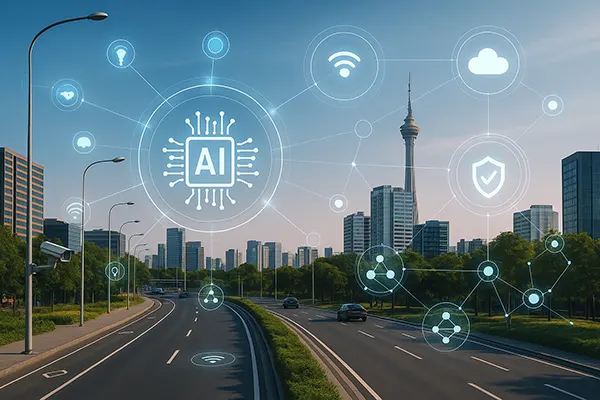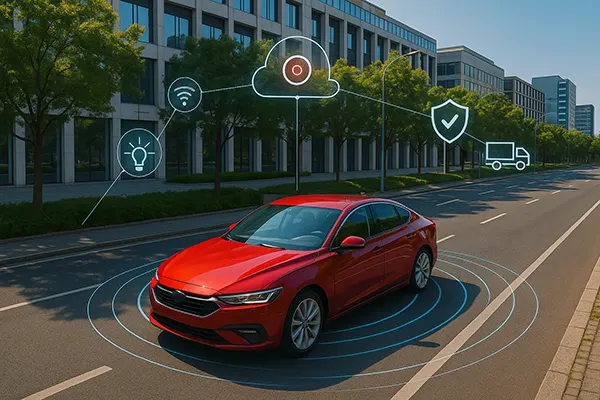
Edge AI in Smart Cities: A Decentralised Approach to Data Processing
As urban environments evolve into interconnected ecosystems, the integration of Edge AI into smart city infrastructures has become a defining trend. This decentralised model offers transformative potential by processing data locally, reducing latency, and enhancing decision-making across various public services. By June 2025, major cities worldwide are actively exploring or implementing Edge AI systems to manage traffic, energy, security, and urban planning more effectively.
Benefits of Edge AI in Urban Infrastructure
Edge AI, by relocating data processing closer to the source—whether it’s cameras, sensors, or mobile devices—dramatically reduces the time required for data analysis. This speed is critical in time-sensitive environments such as traffic control or emergency response. In cities like Seoul, Amsterdam, and Dubai, Edge AI has already been deployed to improve real-time analytics in transportation systems, leading to smoother traffic flow and fewer accidents.
Another key benefit is privacy protection. Since data doesn’t always need to be sent to central servers or the cloud, sensitive information, such as facial recognition inputs or healthcare data, can be processed on-site. This compliance with privacy regulations, including GDPR, is increasingly crucial as surveillance and smart services expand in urban areas.
Moreover, Edge AI reduces network congestion and cloud dependence. By lowering the volume of data that needs transmission, it relieves pressure on citywide bandwidth and ensures continuity even during network outages. This resilience has proven vital during infrastructure stress events, such as natural disasters or large-scale public gatherings.
Real-World Applications Already in Use
In Barcelona, Edge AI is employed in waste management systems that detect bin fill levels and optimise collection routes in real-time. This has led to cost reductions and improved environmental performance. In Singapore, smart lampposts equipped with Edge AI analyse foot traffic and environmental conditions, enabling dynamic lighting control and air quality monitoring without constant cloud connection.
London has also begun testing Edge AI in policing, using it to monitor public spaces and detect anomalies such as unattended bags or aggressive behaviour. These systems help authorities respond faster, with reduced reliance on human operators monitoring dozens of CCTV feeds.
These implementations indicate that Edge AI is not a future possibility—it’s a present-day tool reshaping how cities function and respond to complex challenges, from congestion to climate change.
Technical Challenges and Infrastructure Needs
Despite its promise, Edge AI requires robust infrastructure to function reliably at scale. This includes widespread deployment of intelligent edge devices and maintenance of distributed computing nodes. Power supply continuity, hardware resilience, and secure firmware updates are technical concerns that cities must address to ensure the longevity and safety of their systems.
Edge AI also demands a skilled workforce capable of maintaining and upgrading localised systems. Unlike cloud-based models, edge devices require regular physical oversight and integration with existing municipal IT systems. The gap between technological capacity and municipal budget constraints often slows deployment in smaller cities.
Another challenge is data standardisation. Urban data collected from thousands of sources must be normalised and made interoperable. Initiatives such as FIWARE in Europe or NIST’s Smart City framework in the US are working towards creating unified standards to ensure devices from different vendors can communicate effectively in Edge AI environments.
Security Risks and Ethical Considerations
Local data processing raises unique cybersecurity challenges. Edge devices are often more vulnerable to tampering due to their physical location in public spaces. Ensuring encrypted communication, firmware integrity, and rapid patching of vulnerabilities is paramount for any city deploying Edge AI systems.
Ethical issues, such as biased algorithms or lack of transparency in automated decisions, remain a concern. Smart policing and surveillance tools must be subject to public oversight to prevent misuse. Cities like San Francisco and Berlin have introduced ethical frameworks and AI auditing protocols to address these risks.
Transparency in how data is used, stored, and processed must be clearly communicated to the public. Cities that involve citizens in the decision-making and testing phases tend to see higher acceptance and more effective integration of Edge AI systems.

Future Outlook and Global Momentum
By mid-2025, global investments in Edge AI technologies for smart cities have surpassed $25 billion, according to a McKinsey report. Urban centres in Asia and the Middle East are leading adoption, driven by rapid population growth, high-density environments, and supportive policy frameworks.
In Tokyo, Edge AI is being combined with 6G trial infrastructure to enable autonomous delivery robots and real-time crowd analytics during large-scale events. Similarly, Riyadh has launched a smart governance initiative incorporating decentralised AI in education and municipal decision-making.
Europe is focusing on sustainability, using Edge AI to optimise district heating, monitor air quality, and reduce energy waste in historical city centres. This localised intelligence enables cities to balance environmental commitments with efficient public service delivery.
How Cities Can Prepare for Adoption
Municipalities should start with small-scale pilot projects that align with their most urgent urban challenges. Whether improving traffic safety or reducing energy waste, targeted deployments allow for manageable investment and clearer ROI assessment.
Partnerships with tech companies, academic institutions, and citizens themselves are crucial. These collaborations help cities access the expertise needed to deploy, maintain, and govern Edge AI systems responsibly. Open data platforms and innovation grants can further accelerate progress.
Finally, regulatory frameworks must evolve to reflect the new decentralised reality. Data protection laws, procurement strategies, and public accountability systems should be updated to support safe and equitable Edge AI development across the urban landscape.
